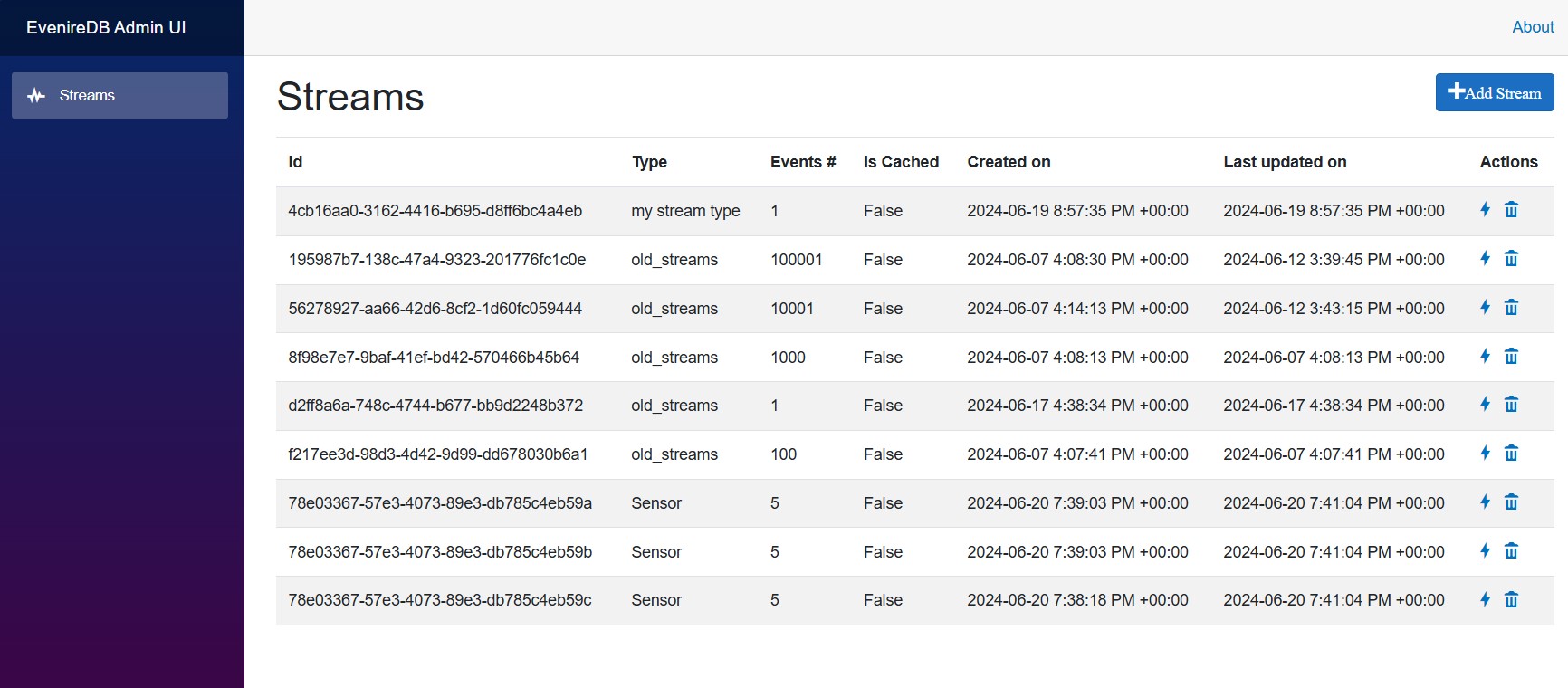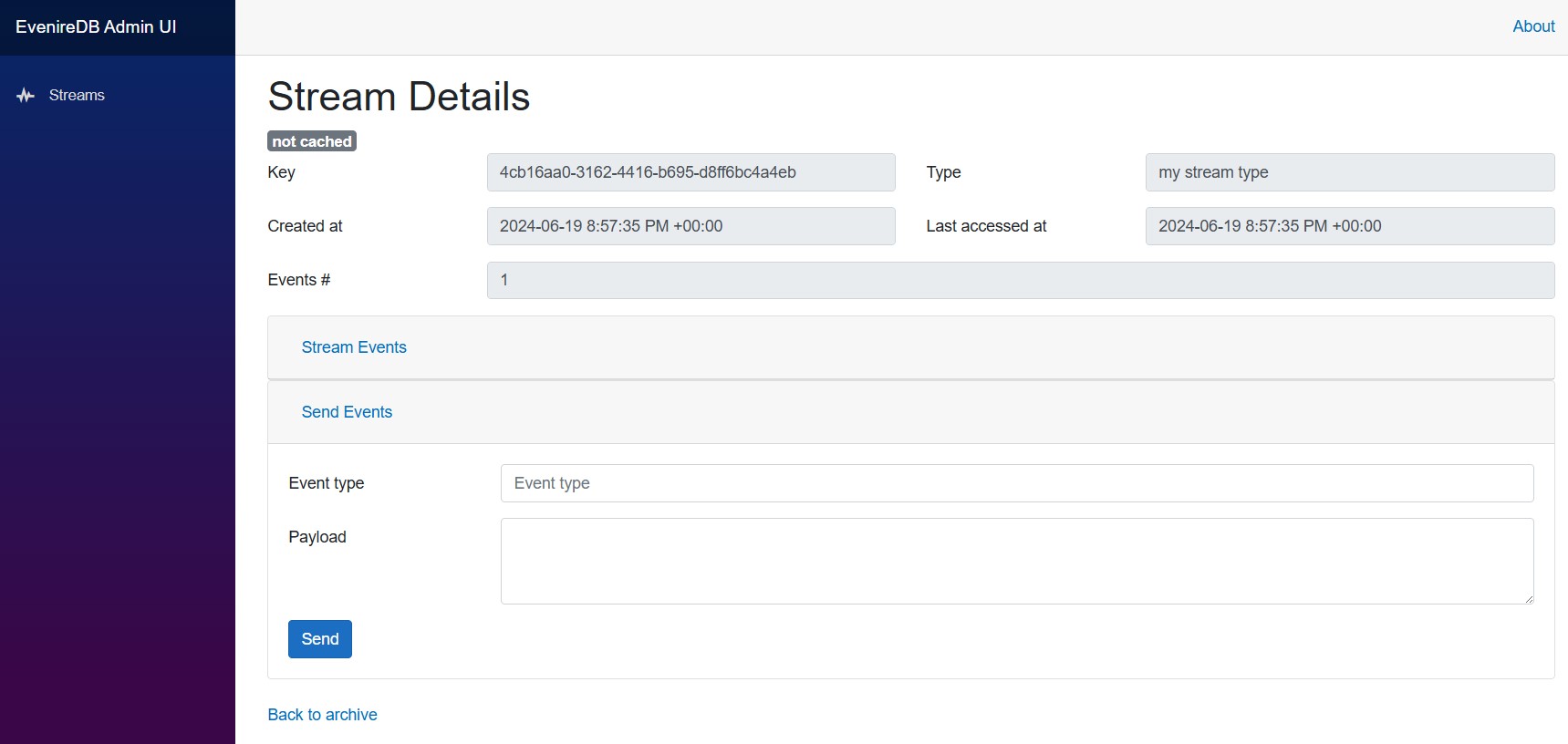EvenireDB.Client
0.0.4
dotnet add package EvenireDB.Client --version 0.0.4
NuGet\Install-Package EvenireDB.Client -Version 0.0.4
<PackageReference Include="EvenireDB.Client" Version="0.0.4" />
paket add EvenireDB.Client --version 0.0.4
#r "nuget: EvenireDB.Client, 0.0.4"
// Install EvenireDB.Client as a Cake Addin #addin nuget:?package=EvenireDB.Client&version=0.0.4 // Install EvenireDB.Client as a Cake Tool #tool nuget:?package=EvenireDB.Client&version=0.0.4
EvenireDB
Evenire, from Latin, present active infinitive of ēveniō, "to happen".
This project is a Proof-of-Concept of a small stream-based DB engine.
One of the potential use cases is Event Sourcing. If you don't know what Event Sourcing is, I've been writing for a while about it on my blog. These articles can be a good starting point:
- Event Sourcing in .NET Core – part 1: a gentle introduction
- Event Sourcing: 5 things to consider when approaching it
I took a personal interest in this amazing pattern and after a while using it, I also wanted to write a database system specifically suited for it. Honestly, I don't know how far this project will go, but I'm having a lot of fun so far and I am definitely learning a lot 😃
How does it work?
The basic idea behind Evenire is quite simple: events can be appended to streams and later on, retrieved by providing the stream ID.
Streams are identified by a tuple composed of a Guid (the stream key) and a string (the stream type). For the curious, the sources are here).
Every stream is kept in memory using a local cache, for fast retrieval. A background process takes care of serializing events to a file, one per stream.
Reading can happen from the very beginning of a stream moving forward or from a specific point. This is the basic scenario, useful when you want to rehydrate the state of an Aggregate.
Another option is to read the events from the end of the stream instead, moving backward in time. This is interesting for example if you are recording data from sensors and you want to retrieve the latest state.
AuthN/Z was left out intentionally as it would go outside the scope of the project (for now).
Setup
As of now, there are two possible options for spinning up an Evenire server:
- deploying the Server project somewhere
- building the docker image and deploying it somewhere
These are both viable options, however, I would recommend opting for the Docker solution as it will package everything you need in the container. Building the image can be done using this script.
Once you have the image ready, you can run it in a Container by running docker compose up.
Client configuration
Once your server is up, you can start using it to store your events. If you are writing a .NET application, you can leverage the Client library I provided.
Client configuration is pretty easy. The first step is to update your appsettings.json file and add a new section:
{
"Evenire": {
"ServerUri": "[your server url here]",
"HttpSettings": {
"Port": 80 <---- make sure this is correct for you
},
"GrpcSettings": {
"Port": 5243 <---- make sure this is correct for you
}
}
}
Once you have that, the last step is to register EvenireDB on your DI container. Something like this:
var builder = WebApplication.CreateBuilder(args);
var clientConfig = builder.Configuration.GetSection("Evenire").Get<EvenireClientConfig>();
builder.Services.AddEvenireDB(clientConfig);
Writing events
Once you have added the Client to your DI Container, just inject IEventsClient into your classes and start making calls to it:
var streamKey = /* this is a GUID */;
var streamId = new StreamId(streamKey, "MyStreamType");
await _eventsClient.AppendAsync(streamId, new[]
{
Event.Create(new{ Foo = "bar" }, "Event type 1"),
Event.Create(new{ Bar = "Baz" }, "Event type 1"),
});
Reading events
Reading too can be done trough an IEventsClient instance:
var streamKey = /* this is a GUID */;
var streamId = new StreamId(streamKey, "MyStreamType");
// write some events for streamId...
await foreach(var @event in client.ReadAsync(streamId, StreamPosition.Start, Direction.Forward).ConfigureAwait(false)){
// do something with the event
}
ReadAsync can be configured to fetch the events from StreamPosition.Start, StreamPosition.End or a specific point in the stream. You can also specify the direction you want to move (forward or backward).
Admin UI
Evenire also has a rudimentary administration UI, written with Blazor. It allows a few basic operations:
- see the list of all the available streams
- create a new stream
- append events to an existing stream
- delete a stream


Samples
- TemperatureSensors shows how to use a Background worker to produce events and uses Minimal APIs to retrieve the latest events for a specific stream.
TODO
- snapshots
- backup and replicas
- cluster management
| Product | Versions Compatible and additional computed target framework versions. |
|---|---|
| .NET | net8.0 is compatible. net8.0-android was computed. net8.0-browser was computed. net8.0-ios was computed. net8.0-maccatalyst was computed. net8.0-macos was computed. net8.0-tvos was computed. net8.0-windows was computed. net9.0 was computed. net9.0-android was computed. net9.0-browser was computed. net9.0-ios was computed. net9.0-maccatalyst was computed. net9.0-macos was computed. net9.0-tvos was computed. net9.0-windows was computed. |
-
net8.0
- Google.Protobuf (>= 3.25.3)
- Grpc.AspNetCore (>= 2.60.0)
- Microsoft.Extensions.Http.Polly (>= 8.0.2)
- Polly.Contrib.WaitAndRetry (>= 1.1.1)
NuGet packages
This package is not used by any NuGet packages.
GitHub repositories (1)
Showing the top 1 popular GitHub repositories that depend on EvenireDB.Client:
| Repository | Stars |
|---|---|
|
mizrael/SuperSafeBank
Sample Event Sourcing implementation with .NET Core
|

